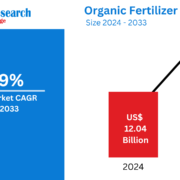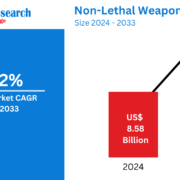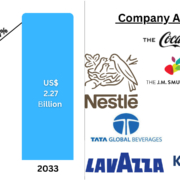Halal Food Market Insights 2025-2033| Growth & Opportunity Analysis
Press Release: Global Halal Food Market Size, Share & Forecast 2025–2033
Description: The global halal food market is anticipated to surge from US$ 2,671.87 billion in 2024 to US$ 5,963.06 billion by 2033, expanding at a robust CAGR of 9.33% over the forecast period. This remarkable growth is underpinned by the rising global Muslim population, increasing demand for clean-label and ethically sourced foods, the proliferation of digital commerce, and government support through standardized halal regulations. This press release provides a detailed outlook on market drivers, trends, challenges, segmentation, and key players shaping the global halal food industry landscape.
Table of Contents
- Market Overview and Outlook
- Key Market Drivers
- Emerging Trends
- Challenges and Market Barriers
- Halal Certification and Regulatory Landscape
- Regional Market Insights
- Consumer Behavior and Preferences
- Segmentation Analysis
- By Product Type
- By Distribution Channel
- By Geography
- Competitive Landscape
- Key Players – Company Profiles
- Conclusion and Strategic Recommendations
Halal Food Market Size & Forecast (2025–2033):
- 2024: US$ 2,671.87 billion
- 2033: US$ 5,963.06 billion
- CAGR (2025–2033): 9.33%
Market Overview Halal food, derived from the Arabic word meaning “permissible,” adheres to Islamic dietary laws. Increasingly, halal food is transcending religious boundaries and is being embraced globally for its hygiene, safety, and ethical sourcing. The halal ecosystem includes stringent control over sourcing, processing, labeling, and packaging to comply with Shariah laws.
Key Market Drivers
- Demographic Shifts: The Pew Research Center forecasts a 70% growth in the global Muslim population by 2060, significantly increasing halal food demand.
- Health & Safety Concerns: Consumers associate halal food with higher hygiene, quality assurance, and ethical standards.
- E-Commerce Expansion: The rise of online grocery and food delivery platforms facilitates wider accessibility to halal-certified goods.
- Globalization of Halal Trade: As Muslim tourism increases, non-Muslim-majority countries are responding by expanding halal offerings.
Emerging Trends in the Halal Food Industry
- Premiumization: High-income consumers in developed markets are willing to pay a premium for halal-certified products perceived as cleaner and healthier.
- Technological Integration: Innovations like blockchain for traceability, 3D food printing, and plant-based halal meat are enhancing production and appeal.
- Veganism & Ethical Eating: The alignment between vegan/vegetarian diets and halal guidelines is expanding the consumer base.
Challenges
- Stereotypes & Misconceptions: Non-Muslim consumers often view halal food as religious-specific, limiting broader market penetration.
- Lack of Consumer Awareness: In non-Muslim regions, many are unaware of halal certification benefits or standards.
- Complex Supply Chains: Global halal certification requirements vary, adding cost and complexity for exporters.
Halal Certification & Regulatory Landscape
- Certification involves a detailed audit of sourcing, slaughtering (for meat), processing, storage, and packaging practices.
- Countries like Malaysia and the UAE have stringent, government-enforced halal standards.
- ISO standards such as ISO 22000 are often integrated with halal certification for food safety.
Regional Insights
- Middle East: High demand driven by state regulation and religious obligation. Key countries: Saudi Arabia, UAE, Qatar.
- Asia-Pacific: Fastest-growing region led by Indonesia, Malaysia, and India due to large Muslim populations and rising disposable income.
- North America & Europe: Significant growth driven by multicultural societies, increased Muslim immigration, and broader acceptance among non-Muslims.
Consumer Preferences
- Packaged Halal Foods: Popular in urban areas for convenience, shelf life, and transparent certification.
- Fresh Halal Foods: Still preferred by traditional consumers valuing freshness and local sourcing.
Segmentation Analysis By Product Type
- Meat
- Poultry & Seafood
- Fruits & Vegetables
- Dairy Products
- Cereals & Grains
- Oil
- Fats & Waxes
- Confectionery
- Others
By Distribution Channel
- Hypermarkets & Supermarkets
- Online Stores
- Convenience Stores
- Specialty Stores
- Others
By Geography (25 Countries)
- North America: United States, Canada
- Europe: UK, France, Germany, Italy, Russia, Turkey
- Asia: Indonesia, Pakistan, India, Malaysia, China, Bangladesh, Kazakhstan
- Middle East & Africa: UAE, Saudi Arabia, Egypt, Qatar, Iran, Iraq, Morocco, Algeria, Nigeria
- Rest of the World
Country-Level Spotlights
- United States: Rising halal food consumption among Muslims and health-conscious non-Muslims. Major demand in urban centers.
- United Kingdom: Expanding halal offerings in mainstream supermarkets. Popular among Muslims and ethical food buyers.
- India: Massive Muslim demographic supports halal growth. Increasing interest from health-focused and ethical consumers.
- UAE: Regional hub for halal exports. High tourist influx drives retail and hospitality-based demand.
Competitive Landscape Key Players – Overview, Recent Developments, Revenue Analysis
- Nestlé SA (Switzerland) – Halal-certified dairy, infant nutrition, beverages. Strong MENA & Asia presence.
- JBS SA (Brazil) – Halal beef & poultry through Seara & Friboi brands.
- BRF SA (Brazil) – OneFoods brand with strong GCC market.
- Kawan Food Berhad (Malaysia) – Frozen parathas and Asian meals.
- Cargill Inc. (USA) – Global halal beef and poultry supplier.
- Carrefour SA (France) – Private-label halal food lines in Europe & Middle East.
- Crescent Foods Inc. (USA) – Wide halal meat selection for North American markets.
- VegaVites (USA) – Halal-certified gummy vitamins and supplements.
- American Halal Co. (Saffron Road) – Halal frozen entrees and snacks in 25,000+ US stores.
- American Foods Group LLC (USA) – Major supplier of halal meat products.
- Al Islami Foods (UAE) – Dominant halal frozen brand across MENA.
Conclusion & Strategic Recommendations The global halal food market is entering a transformative phase where cultural, technological, and ethical drivers are converging. To capitalize on this growth:
- Brands should invest in halal certification and transparent labeling.
- Governments must harmonize standards to simplify global trade.
- Stakeholders should prioritize consumer education across demographics.
- Innovation in plant-based, clean-label, and fortified halal products will open new consumer segments.
As demand continues to rise beyond religious boundaries, the halal food market represents not just a religious or cultural preference, but a broader movement toward ethical and health-conscious consumption worldwide.
About the Company:
Renub Research is a Market Research and Consulting Company. We have more than 15 years of experience especially in international Business-to-Business Researches, Surveys and Consulting. We provide a wide range of business research solutions that helps companies in making better business decisions. We partner with clients in all sectors and regions to identify their highest-value opportunities, address their most critical challenges, and transform their businesses. Our wide clientele comprises major players in Healthcare, Travel and Tourism, Food Beverages, Power Energy, Information Technology, Telecom Internet, Chemical, Logistics Automotive, Consumer Goods Retail, Building, and Construction, Agriculture. Our core team is comprised of experienced people holding graduate, postgraduate, and Ph.D. degrees in Finance, Marketing, Human Resource, Bio-Technology, Medicine, Information Technology, Environmental Science, and many more.
Media Contact:
Company Name: Renub Research
Contact Person: Rajat Gupta, Marketing Manager
Phone No: +91-120-421-9822 (IND) | +1-478-202-3244 (USA)
Email: mailto:rajat@renub.com










